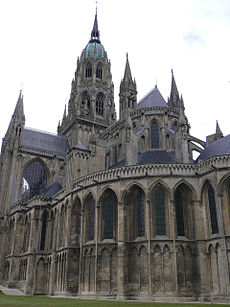Bishop of Bayeux
|
Diocese of Bayeux and Lisieux Dioecesis Baiocensis et Lexoviensis Diocèse de Bayeux et Lisieux |
|
|---|---|

|
|
| Location | |
| Country | |
| Ecclesiastical province | Rouen |
| Metropolitan | Archdiocese of Rouen |
| Statistics | |
| Area | 5,548 km2 (2,142 sq mi) |
| Population - Total - Catholics |
(as of 2012) 694,600 493,700 (71.1%) |
| Parishes | 51 |
| Information | |
| Denomination | Roman Catholic |
| Sui iuris church | Latin Church |
| Rite | Roman Rite |
| Established | 2nd Century (As Diocese of Bayeux) 12 June 1855 (As Diocese of Bayeux-Lisieux) |
| Cathedral | Cathedral of Notre Dame in Bayeux |
| Co-cathedral | Co-Cathedral of St. Peter in Lisieux |
| Current leadership | |
| Pope | Francis |
| Bishop | Jean-Claude Boulanger |
| Metropolitan Archbishop | Jean-Charles Marie Descubes |
| Emeritus Bishops | Pierre Auguste Gratien Pican Bishop Emeritus (1988-2010) Guy Gaucher Auxiliary Bishop Emeritus (1987-2005) |
| Website | |
| Website of the Diocese | |
The Roman Catholic Diocese of Bayeux and Lisieux (Latin: Dioecesis Baiocensis et Lexoviensis; French: Diocèse de Bayeux et Lisieux) is a diocese of the Roman Catholic Church in France. The diocese is coextensive with the Department of Calvados, and is a suffragan to the Archdiocese of Rouen, also in Normandy.
At the time of the Concordat of 1802, the ancient Diocese of Lisieux was united to that of Bayeux. A pontifical Brief, in 1854, authorized the Bishop of Bayeux to call himself Bishop of Bayeux and Lisieux.
A local legend, found in the breviaries of the 15th century, makes St. Exuperius, first Bishop of Bayeux, an immediate disciple of St. Clement, and his see a foundation of the 1st century; St. Regnobertus, the same legend tells us, was the successor of St. Exuperius, but the Bollandists and M. Jules Lair found little ground for this legend; it was only towards the middle of the 4th century that St. Exuperius founded the See of Bayeux; after him the priest St. Reverendus worked to spread Christianity in these parts.
Certain successors of St. Exuperius were saints: Rufinianus; Lupus (about 465); Vigor (beginning of the 6th century), who destroyed a pagan temple, then still frequented; Regnobertus (about 629), who founded many churches, and whom the legend, owing to an anachronism, made first successor to Exuperius; and Hugues (d. 730), simultaneously bishop of two other sees, Paris and Rouen.
We may also mention Odon of Conteville (1050–97), brother of William the Conqueror, who built the cathedral, was present at the Battle of Hastings, intrigued for the tiara on the death of Gregory VII (1085), and died a crusader in Sicily; Cardinal Trivulce (1531–48), papal legate in the Roman Campagna during the siege and pillage of Rome by the Constable de Bourbon; Arnaud Cardinal d'Ossat (1602–04), an illustrious diplomatist prominently identified with the conversion of Henry IV of France. Claude Fauchet, who after being court preacher to Louis XVI, became one of the "conquerors" of the Bastille, was chosen Constitutional Bishop of Bayeux in 1791, and was beheaded 31 October 1793. Léon-Adolphe Amette, Archbishop of Paris was, until 1905, Bishop of Bayeux.
...
Wikipedia
